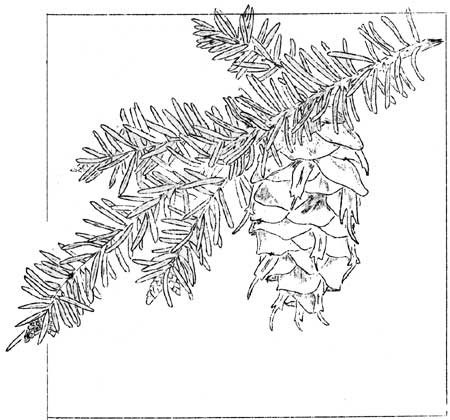DOUGLAS FIR.
(Pseudotsuga taxifolia)
This is the most important commercial cone-bearing tree in the world
and, with the exception of the sequoias, the largest and most
magnificent species on the Pacific Coast. While not as abundant as the
western hemlock in the forests of Mount Rainier National Park, its great
size and commanding appearance stamps it as "king" of local trees. It is
found from the lower park boundaries to an upper altitudinal limit of
approximately 4800 feet but is most common in the deep woods of the
lower slopes.
Under proper conditions mature trees attain a height of from
150-200 feet and a diameter of from 3-6 feet, although larger
trees are often found. The massive trunks of mature Douglas firs can be
readily recognized by their deeply furrowed, cinnamon-brown bark.
Young trees (from 10 to 18 inches in diameter) have dark ash-grey bark.
The inner bark of both large and small trees, except those of the very
young age classes, presents a mottled cream and brown effect. The
foliage is yellow-green, the individual needles being about 1
inch long, flat, soft to the touch, generally blunt but occasionally
pointed, and narrowed at the base into a short petiole. Numerous pendant
side branches are characteristic of the rather open crown. In the
early summer the small, red pistillate flowers are quite
attractive. These mature as cones in one season which are one of
the most characteristic features of the tree. They are about 3 inches
long and 1-1/2 inch in diameter with three-pointed bracts protruding
from between the scales.
The Douglas fir grows rapidly during its youth and is also a tree of
great age, the largest specimens in the park no doubt being about 800
years old. Trees 3-4 feet in diameter are generally from 150-200 years
of age end the tree, which provided the section which stands in front of
the park museum at Longmire and which is 5-1/2 feet in diameter, was
nearly 700 years old when blown down in a severe wind storm.
Most everyone will notice that, while the western hemlock is the most
numerous tree in the dense forests of the lower elevations, the larger
trees are invariably Douglas firs. This may be accounted for by the fact
that they are survivors of a more extensive Douglas fir forest which
originally characterized this area. Being intolerant of shade and
therefore unable to compete with the western hemlock in the dense
forests, the Douglas fir is being gradually supplanted by the more
tolerant hemlock which climaxes the succession.
Although this species occurs over a wide botanical range,
nowhere does it attain the great size or the commercial importance which
characterizes this tree in the humid forests of the Pacific Northwest.
It will be found from British Columbia to central California along the
Pacific Coast and, inland, from British Columbia as far south as
northern Mexico through the Rocky Mountain section of the west.

DOUGLAS FIR. (Pseudotsuga taxifolia). Twig, illustrating
character of the cones and foliage (x1). Note the three-pointed bracts
extending from between the cone scales.
-oOo-
Descriptions continued...

